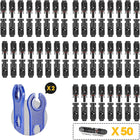How to Choose Solar PV System Wiring

For any solar project, you need a solar cable to string together the solar hardware, like solar panels, controllers, batteries, and inverters. It ensures efficient power flow while maintaining safety standards. Key parameters include wire gauge (thickness), current capacity, and voltage drop over distance.
While basic cables are often included in solar panel systems, selecting independent cables may be necessary to meet specific project needs. This guide will cover the basics of solar cables while emphasizing the importance of these cables for any functional solar system.
Understanding Wire Conductivity
An electrical wire carries current similar to how a water hose carries water. A larger diameter hose has less resistance and allows better flow, especially if the hose is shorter. Electrical wires work the same way: thicker and shorter wires have less resistance. If your wires are too thin or too long, resistance increases, causing power loss to your battery bank or the grid.
Copper wires are measured using the American Wire Gauge (AWG) scale. A lower gauge number means less resistance and a higher capacity to handle current safely. The "Electrical Cable Size Chart Amps" shows the current-carrying capacity for wires in a conduit, based on NEC 310.17 Table rated at 90℃ (194℉).

Example
Taking 8-gauge wire as an example, the recommended current carrying capacity can reach 50A for lengths shorter than 30ft. However, when the length reaches 50ft, the recommended current carrying capacity drops to only 22-24A.
Meter ⇔ Feet Converter
When selecting which wire gauge to connect use it is also important to consider:
- How long the cable needs to be?
- How many continuous Amps go through the wire?
Types of Wires in a Solar PV System
In a typical solar PV system, you'll find the following types of wiring:
- Wires connecting solar panels to the charge controller

- Wires connecting the charge controller to the battery bank

- Wires interconnecting batteries (if applicable)

- Wires connecting the battery bank to the inverter

Guidelines for Selecting Each Type of Wire
1. Choosing Wires for Solar Panel to Charge Controller
Solar Adaptor Kit (SKU: ISE003-B021)
To calculate the required wire current capacity:
Wire Amp Rating ≥ Number of Panels in parallel × Short Circuit Current (Isc) × 1.25
Round up the result and consider the wire length.
EXAMPLE:
For three 200W panels connected in parallel, each at 20 volts with an Isc of 10 amps, the total output is 20 volts and 30 amps.
Parallel Volts = V1 = V2
Parallel Amps = A1 + A2
Using the formula:
Wire Amp Rating ≥ 3 × 10A × 1.25
Wire Amp Rating ≥ 46.88A
If the distance between the solar panels and the charge controller is 13 feet, use 10-gauge wires according to the "Electrical Cable Size Chart Amps."
2. Choosing Wires for Charge Controller to Battery Bank
SKU: ISE107ISE107
Formula to calculate the current capacity required for the wire: Wire Amp Rating ≥ Battery Charging current*1.25
3. Choosing Wires for Battery Interconnection
SKU: ISE208ISE208
To determine the wire current capacity for the battery:
1). Identify the battery's Max Continuous Charge/Discharge Current.
2). Use the formula: Wire Amp Rating ≥ Inverter Continuous Power Rating / Peak Efficiency / System Voltage/ Numbers of Battery in parallel × 1.25.
3). Round up the result and consider the wire length.
4. Choosing Wires for Battery Bank to Inverter
SKU: ISE208
To calculate the required wire current capacity:
Wire Amp Rating ≥ Inverter Continuous Power Rating / Peak Efficiency / System Voltage × 1.25
Example:
1000W / 0.90 / 12V × 1.25
≥ 115.74 Amps
Round up the result and consider the wire length.
Conclusion
Selecting the right wires ensures optimal performance and safety of your solar PV system. Always consider the specific current requirements and distances involved to minimize energy loss and maximize efficiency. By following these guidelines, even beginners can confidently set up and maintain their solar systems with the appropriate wiring solutions.
Explore more: Solar Cable Size Chart for Quick and Efficient Planning















































































































































































































